
More About the Early History
of Bassets
Prior to 1866 and their Introduction to England
Dogs were highly valued in Egypt as part of the family and, when a dog died, the family would have the dog mummified with as much care as they would pay for a human member of the family. Great grief was displayed over the death of a family dog and the family members would shave their bodies completely, including the eyebrows. As most Egyptian men and women shaved their heads to avoid lice and maintain basic hygiene, the absence of the eyebrows was the most notable sign of grief. Even so, it was believed that one would meet one's canine friend again in the afterlife. Tomb paintings of the pharaoh Rameses the Great depict him with his hunting dogs in the Field of Reeds and dogs were often buried with their masters to provide this kind of companionship in the afterlife. The intimate relationship between dogs and their masters in Egypt is made clear through inscriptions in tombs, monuments, and temples.
The Libyans had good hounds and the Cyrenean hounds were allegedly crossed with wolves, with lurcher-like all-purpose hunting dogs known to exist in central and southern Africa. In ancient Greece, Epirus in the extreme north-west, produced the Acarnanians, which unusually for those times ran mute, the Athamanians, the Chaonians (from which came the legendary Laelaps) and the longer-eared Molossian hound. Since the cynologist Otto Keller produced his personal theory which linked the latter with the big mountain dogs of Tibet and then with the Tibetan wolf, mastiff and Great Dane researchers have had a field day. The Molossians of ancient Greece were in fact usually sheepdogs, sometimes shaggy-coated and often white. Xenophon refered to the Locrians as the powerful short-faced boar-hunting hounds.
Equally important however is the Cretan hound, a superb tracker in the mountains, with one variety the "outrunners" running free, under the control of the huntsman's voice only, the first to do so in Europe until the end of the sixteenth century. The Cretan was subsequently crossed with the Laconian to produce the Metagon, so highly praised by Gratius but strangely by no other. It could be that the stamina-packed Laconian of the Greeks was crossed with the skilled trackers, the Segusiae of the Celts, to found the subsequent scenthound types further north, the Norman hounds, St. Huberts, the great white hounds of France and the grey hounds of St. Louis. In time specialised functions led to specialist breeds; the Franks for example developing specialist hunting dogs to support their expert bersarii (for large game), veltrarii (for greyhounds), beverarici (for beavers and otters), falconers and wolf-hunters. In wolf-hunting, scenthounds and sighthounds were used in mutual support. Leashed scenthounds were usually employed to put the whole pack on the correct line, rather as 'tufters' do in stag-hunting to this day. Hunting with hounds became the obsession of noblemen all over the world, fortified by the medieval superstition that the strength and guile of animals passed on to man when he ate their flesh. Parforce hunting relying on the strength of hounds may have been replaced by "hunting cunning" which relies on the unraveling of confused scent by skilful hounds and big game hunting with giant hounds may have lapsed. But the pursuit of game by man with hounds spans eleven thousand years and from such a heritage is likely to survive modern pressures just as the hounds themselves have adapted to each century.
The basset type of dog is thought to have originated in France, and is believed to be a decendent of the 6th century hounds belonging to St Hubert of Belgium, which through breeding at the Benedictine Abbey of St. Hubert eventually became what is known as the St Hubert's Hound around 1000AD. St Hubert's original hounds are descended from the Laconian (Spartas) Hound, one of four groups of dogs discerned from Greek representations and descriptions. These scent hounds were described as large, slow, 'short-legged and deep mouthed' dogs with a small head, straight nose, upright ears and long neck, and either tan with white markings or black with tan markings. Laconian Hounds were reputed to not give up the scent until they found their prey. They eventually found their way to Constantinople, and from there to Europe. The illustrations of Laconian Hounds that survive do not reflect the description of having short legs. Whether or not these hounds are actually ancestors of the Saint Hubert Hounds isn't truly known.
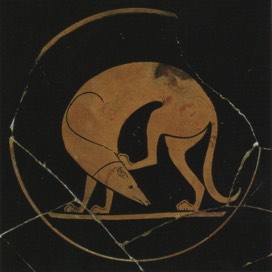
The Euergides Painter (active c. 500 BC) Detail of a Laconian hound scratching its head, from an Attic red-figure cup c. 500 BC Painted pottery
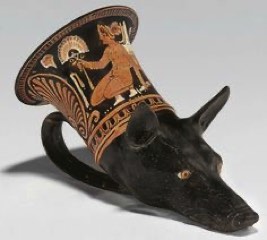
An Apulian red-figured rhyton, circa 340 B.C. Molded in the form of the head of a Laconian hound with a long tapering muzzle.

Dogs of Egypt: 1, one of the favorite dogs of King Antef, from his funereal stele. Fig. 2, bitch depicted in a Theban tomb of the twentieth dynasty. Fig. 3, hound from the tomb of Anna at Thebes (eighteenth dynasty ), from a drawing by M. Boussac.
There are many references to short legged hounds throughout Europe as early as the 1500s. It is believed that these hounds were descendants of hounds developed by St. Hubert. In Turbeville's Art of Venerie (Art of Hunt) in 1576 “St. Huberts are described as being mighty of body, legs low and short, not swift, but good on scent." Over the pursuing years the St. Hubert Hound evolved in several regions in France. They were used for different quarry based on the region they were in. In 1585 the first mention of "basset" or "low" appears in Jacques de Fouilloux's La Venerie (The Hunt) describing a hound used to hunt badger. He specifically notes a crooked legged smooth coat hound that works best in undergrowth. Any hound lower than 16 inches was called a basset. There were as many as twelve variations of these short hounds in France. They were also found in other parts of Europe. As forms of hunting changed to include shooting, these hounds spread in popularity through France, where hunting and hound breeding was taken seriously by the ruling classes. It’s important to note that rabbits were considered vermin because they destroyed cropsThe dogs in Fouilloux's text were used to hunt foxes and badgers. It is believed that the Basset type originated as a mutation in the litters of Norman Staghounds, a descendant of the St Hubert's Hound. These precursors were most likely bred back to the St. Hubert's Hound, among other derivative French hounds.
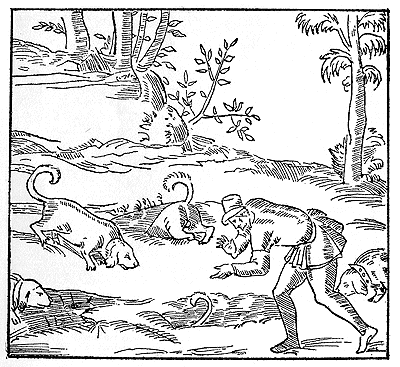

Basset type hounds became popular during the reign of Emperor Napoleon III (r. 1852-1870). In 1853, Emmanuel Fremiet, "the leading sculptor of animals in his day" exhibited bronze sculptures of Emperor Napoleon III's basset hounds at the Paris Salon.
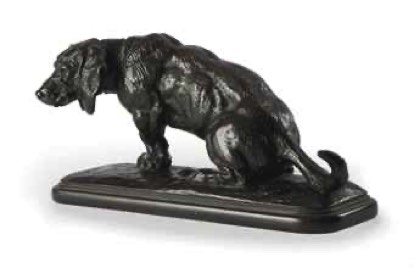
Illustrations from Jacques de Fouilloux's La Venerie of a "basset" dog. At this time any dog that was sixteen inches tall or shorter was considered a basset. These dogs were not necessarily what we would call a Basset Hound today though they could be related.
Perhaps, however, for us Basset Hound lovers the most important was the Greek hound, the Laconian, sometimes called the Spartan hound especially since many feel that this hound was the foundation of Saint Hubert's Hounds. This hound was good enough to be held in high esteem for many centuries, hence the Shakespearean reference--although the description there is not accurate. We have on record a great deal of information on the Laconian hound, a harrier-sized scenthound with small prick ears, free from throatiness or dewlap. It was more tucked-up than our scenthounds of today but not as much as the modern sighthounds; the contemporary Italian breed, the Segugio, ears apart, being the nearest modern equivalent. Tan and white or black and tan, bold and confident, built like a steeple-chaser, their fame spread wide and their blood was extensively utilised. Xenophon's chief delight was hunting hare with them.

St. Hubert Hound - ffrom La Vénerie, by Jacques du Fouilloux
Basset Hounds Diminutive Canines 1766
Buffon's book on natural history 1797 Bassets
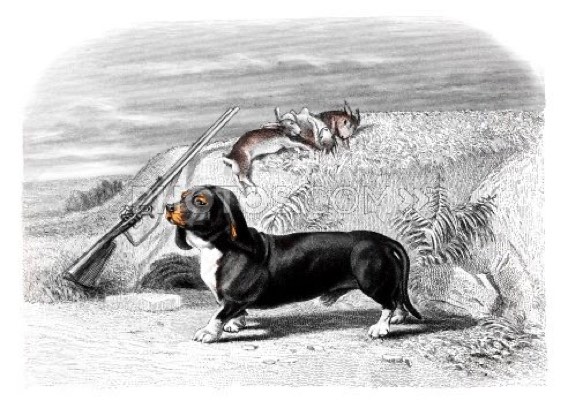
The Book Title 'Oeuvres Completes De Buffon' Published in France 1830-1832
Unfortunately the French Revolution (1789 - 1799) put an abrupt end to the ruling classes in France and also their kennels. Many strains of dogs became extinct including the St. Hubert Hound. As some scholors state, "Most of the dog owning aristocracy of this time literally lost their heads to the guillotine." Very little is know about what happened during this time period in France. The country was in great turmoil and a new aristocracy had not formed. We do have a few illustrations from this time that may help show what was going on with the bassets. The earliest of these artworks is an illustration of a game warden walking with what are apparently two bassets. The publication for this drawing is unknown.
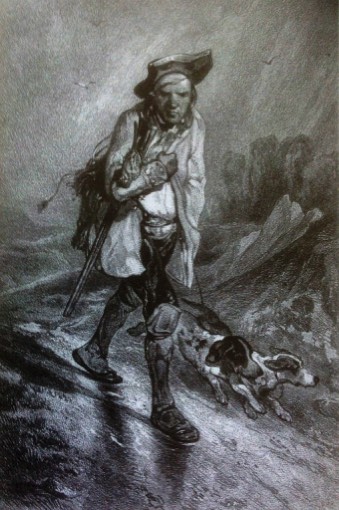
Game warden and his faithful companions in 1840
Basset hound type dog bronze sculpture by Emmanuel Fremiet It was owned by Emperor Napoleon III.
Another bronze of a basset is attributed to a sculptor Bayre with a more specific date, July 4, 1846. The following are drawings of basset type hounds in France.
Bronze basset by Bayre JUL14-1846
The illustrations below are also from the time of uncertainty in France following the French Revolution.
By the 1860s improvements in financial security and transportation had been established in France due to the Industrial Revolution and political changes. The Société impériale zoologique d’acclimatation held the first French dog show in 1863 in Paris. Organized by scientists and members of high society, the show and subsequent ones had a refined and elite atmosphere. Most agree that the popularity of the basset hound can be traced back to its presentation at the Paris Dog Show in 1863. Several breeds of low, basset sized, French hounds were exhibited at that show. Of great importance here are the bassets of Count le Couteulx de Canteleu who spared neither trouble or expense to save excellent examples of the smooth, tricolor basset, a utilitarian type with straight front legs known as the Chien d'Artois. He was assisted by Monsieur Pierre Pichot. Their bassets were exhibited at the Paris show. That is where they were first seen by the public including some British admirers.
In France every smooth-coated basset was called a Basset Francais. In addition to Count le Couteulx de Canteleu, Mr. Louis Lane developed a more spectacular type, with crooked front legs, known as the Basset Normand. These were bred together to create the original Basset Artésien Normand.
Hound like dogs, however, were around much earlier than the the Greeks. Flavius Arrianus, in the second century A.D., described two Celtic breeds, the Segusiae (named after a tribe from a province which included what is now Lyons) with excellent noses, good cry but a tendency to dwell on the scent and the Vertragi (literally "lots of foot"), rough-haired greyhound-like dogs. Claims have been made for the Segusiae being the prototype of our modern scenthounds: bloodhounds, foxhounds, bassets and harriers. But Arrian found nothing remarkable or noteworthy about them, merely explaining that they hunted in the same way as Cretan and Carian hounds. Xenophon records seeing gazehounds in Asia Minor. Most likely the Greeks and Romans found the Celtic greyhound not a new breed but a variety of one of the oldest types in existence. In time the Greeks became aware of the hounds from the Rhineland called Sycambrians, the Pannonian hounds from what is now northern Yugoslavia and the Sarmatian hounds from southern Russia. From the north of the Himalayas came a ferocious breed of hounds known as Seres after the people of that name. From further south came the red-brindle "Indian" hounds, recommended by Xenophon for hunting deer and wild boar. From Persia in early B.C. came the Elymaean hounds (more precisely from the Gulf area), the fierce Carmanians, the savage mastiff-like Hyrcaneans (from the area where Tehran now is and probably more like today's broad-mouthed breeds than any Molossian) and the fighting hounds, the Medians. In Asia Minor were the Carians (from the area where the hound-like Anatolian shepherd dogs of today come from), esteemed by Arrian as tracking hounds, with good nose, pace and cry. The much bigger variety of the Carian, the Magnesian, was a shield-bearer in war. And from the south of this region came the Lycaonian hounds, highly regarded for their admirable temperament. In north Africa, Aristotle tells us that the Egyptians favoured the smaller sighthound type, comparable with the so-called Pharoah hound and whippet of today.
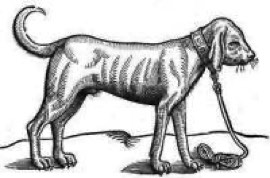
Scent Hound C 1563
This large dog easily reached over 2 feet at the shoulder; it was at the same time powerful and fast, with an excellent nose and eager to hunt all animals. Its dark coat, its fine dense hair, its wide pendulous ears, its head marked with furrows and folds of skin all gave it a distinctive appearance.
Scent Hounds were often called Leash Hounds because they were usually hunted on a leash. The first breed that was created for this specialized hunting by the nobility was the Saint Hubert Hound so called because it was developed by the French monks of the Abbey of Saint Hubert in the Ardennes around 1100 AD. So it was named after its patron who was a celebrated huntsman. This was the also one of the first breeds to be described with a distinctive physical appearance which was as follows:
Scent Hounds were greatly prized by huntsmen of the nobility who wished to hunt stag and wild boar for hours, the most obvious direct descendant of the Saint Hubert Hound being the Bloodhound. Later, his amazing finding or scenting abilities had a great impact on the selective development of many other breeds.
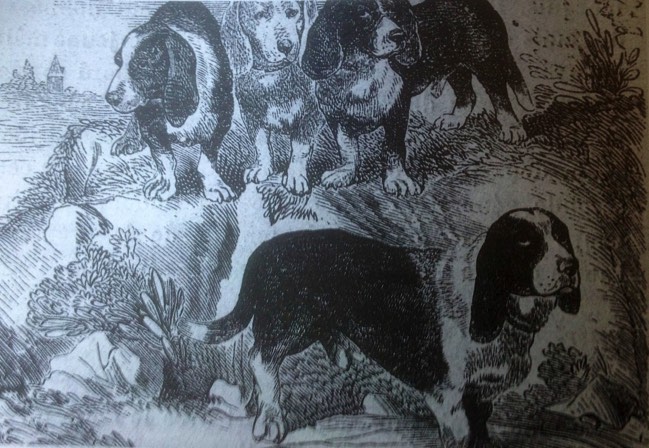
Bassets shown by Pierre Pichot in 1863
During this time little is known about the breeding of bassets in France. We do, however, have a few illustrations that have been attribted to this time period that shed some light on what they looked like. Please note that the captions have not been fully verified as to their accuracy.
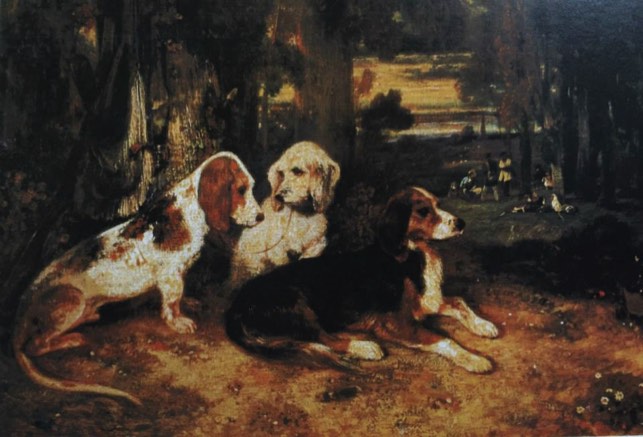
Alexandre-Gabriel Decamps, 1830
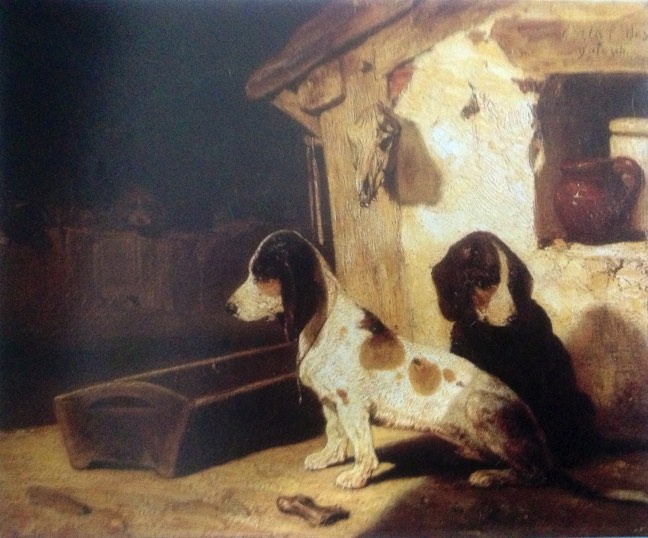
Hospital for the Mangy Alexandre-Gabriel Decamps, 1830.
LINK: French Basset Breeds and Similar Breeds (NOTE: These are current breeds that came from or may have come from the early French hound breeds. Check related websites for the history of these breeds.)
